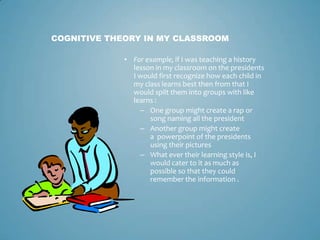Cognitive theory group 3
- 1. COGNITIVIST THEORY Project Group 3 Jessica, Ashley, Staci, and Andrea
- 2. âĒ Cognitivism is a theory which attempts to answer how and why people learn by attributing the process to cognitive activity. âĒ Cognitivism was an attempt to explain what was occurring in the mind during learning, a subject virtually ignored by the previous theories that focused on actions and behaviors of the learner. Actions were deemed valid proof that learning had occurred. KEY FACTS OF COGNITIVIST THEORY
- 3. KEY FACTS OF COGNITIVIST THEORY âĒ The purpose in education is to develop conceptual knowledge, techniques, procedure s, and algorithmic problem solving using Verbal/Linguistic and Logical/Mathematical intelligences. âĒ Main steps to learning are the mental processes of recognize, recall, analyze, reflect, a pply, create, understand, and evaluate.
- 4. IMPORTANT CONTRIBUTORS TO COGNITIVE THEORY Allan Paivio (1925-) âĒ Proposed that presenting information in both visual and verbal form enhances recall and recognition. âĒ Came up with dual coding theory â Assumes that people processed information in two distinctly & different ways âĒ Process of images âĒ Process of language Robert Gagne (1916-2002) âĒ He known for his contributions in the area of cognitive learning hierarchies, which involves the development of skills based on a building-block principle. âĒ His 3 principles: â Providing instruction on the set of component tasks that build toward a final task. â Ensuring that each component task is master â Sequencing the component task to ensure optimal transfer to the final task.
- 5. IMPORTANT CONTRIBUTORS TO COGNITIVE THEORY Howard Gardner (1943-) âĒ A professor at Harvard University âĒ He concludes that people use 8 different intelligence to perceive and understand the world. â Linguistic-verbal â Logical-mathematical â Spatial-visual â Body-kinesthetic â Musical â Interpersonal â Intrapersonal â Naturalist Benjamin Bloom (1913-1999) âĒ Classified learning into 3 groups â Cognitive â Affective â Psychomotor âĒ Made the Bloomâs Taxonomy â Knowledge â Comprehension â Application â Analysis â Synthesis â Evaluation
- 6. CLASSROOM IMPLICATIONS What the teacher does under this theory âĒ Integrates technology through the nine events of instruction (Gagne) to improve the internal process of learning, attention, motivation and recall. 1. Gain attention of the learners 2. Inform the learners of the objective 3. Stimulate recall of prior learning 4. Present the stimulus or learning 5. Provide learning guidance or instruction 6. Elicit performance 7. Provide feedback 8. Assess performance 9. Enhance retention and transfer âĒ This technique enhances and enriches technology plans by appealing to the learners both visually and verbally (Paivio) Another way to integrate technology âĒ Reach students through Gardnerâs Eight Intelligences 1. Linguistic- Verbal â ex. Word processing programs 2. Logical- mathematical- ex. Database programs 3. Spatial- visual- draw and paint programs 4. Body- Kinesthetic- alternate input like tablets 5. Musical- programs with stories and songs 6. Interpersonal- telecommunications program 7. Intrapersonal- tutorial software 8. Naturalist- problem solving software
- 7. âĒ What the students do under this theory (with and without technology) â Bloom focused on the student learning process, defined cognitive theory as what students know and how they organize ideas and thoughts. âĒ Six levels of Bloomâs Taxonomy- Students can use technology to learn better from simple to complex. âĒ Knowledge- Retaining the information âĒ Comprehension- understanding the information âĒ Application- applying it and experimenting âĒ Analysis- analyzes and concludes âĒ Synthesis- collects and develops âĒ Evaluation- Compare and criticize CLASSROOM IMPLICATIONS
- 8. âĒ For example, if I was teaching a history lesson in my classroom on the presidents I would first recognize how each child in my class learns best then from that I would spilt them into groups with like learns : â One group might create a rap or song naming all the president â Another group might create a powerpoint of the presidents using their pictures â What ever their learning style is, I would cater to it as much as possible so that they could remember the information . COGNITIVE THEORY IN MY CLASSROOM
- 9. âĒ All images were found on google images or microsoft clip art âĒ Sources of Information include: â Integrating Technology in a Connected World (Seventh Edition) by Shelly, Gunter and Gunter â http://www.coe.fau.edu/faculty/caf olla/courses/eme6051/cognitivism. htm â http://www.slideshare.net/kmart4 785/cognitivism-10258341 REFERENCES









